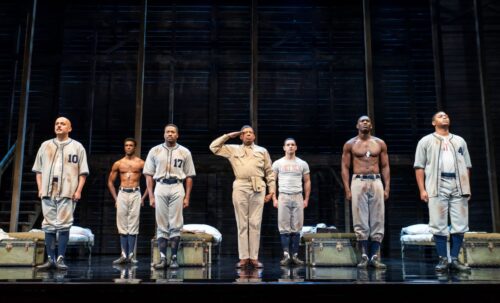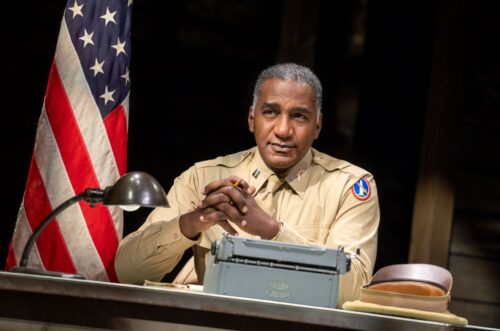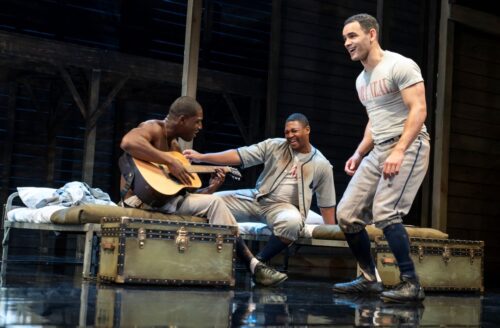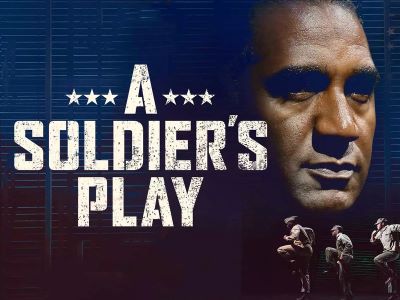THIS WAR WITHIN A WAR
IS COMMANDING AND COMPELLING
The North American tour of A Soldier’s Play — Roundabout’s 2020 Tony Award-winning Best Revival of a Play — opened last Wednesday at L.A.’s Ahmanson Theater and plays through June 25, the end of this tour. Don’t miss it. Broadway star Norm Lewis leads the cast of the military murder investigatory play written by the late Charles Fuller. As swiftly moving as it was in 1981, Fuller’s sturdily written work remains an enduring testament to the home front battles that African-American soldiers fought during World War II, within their ranks as well as with white comrades in arms. It’s a kind of upfront, downhome American classic, and director Kenny Leon and his company lift it not just to relevance, but urgency.
 Howard Overshown, Malik Esoj Childs, Tarik Lowe, Eugene Lee,
Will Adams, Sheldon D. Brown, and Branden Davon Lindsay
Howard Overshown, Malik Esoj Childs, Tarik Lowe, Eugene Lee,
Will Adams, Sheldon D. Brown, and Branden Davon LindsayThe play’s action alternates between real-time barrack scenes with the company of enlistees, interrogation scenes in the captain’s office, and flashbacks resulting from the investigation of the murdered Sergeant Vernon C. Waters, played by Eugene Lee, who lends veteran-like authority to this revival (he played a Corporal in the original Off-Broadway production). He gives an in-your-face, rapid-fire energy to Sergeant Waters. His character has a vision for the future Black man in society as learned men, lawyers and professionals. It is his vehement disdain towards his culturally united company members who do not measure up to his vision that leads to his own demise. Company member Private C.J. Memphis, sweetly and sympathetically played by musically talented Sheldon D. Brown, falls victim to Sergeant Water’s shaming, who dismisses him as “one less fool for the race to be ashamed of.” Through the Sergeant we are witness to the tragedy of self-hate and the hatred of one’s own culture and history. In the character of white Captain Charles Taylor (William Connell), we see the institutional racism, the oppression of a culture backed by the societal history of power to target and victimize Blacks.
Eugene Lee
It’s up to Captain Richard Davenport (eloquently and valiantly portrayed by Norm Lewis), an African-American prosecutor more used to dealing with M.P. incidents than homicides, to find the killer and the cause. Could it be the K.K.K., disgruntled cracker recruits out to eliminate an “uppity” sergeant, or an inside job from Waters’ barracks? Artfully time-shifting between flashbacks and present day, Fuller uses Davenport’s interviews with very different G.I.s, black and white, to hold out suspense until the end. Lewis is no-nonsense and direct, looking gallant and handsome in designer Dede Ayite’s military officer uniform.
 Norm Lewis
Norm LewisMr. Lewis has an effusive charm which is especially enjoyable in the play’s comedic spots. Fortunately, Mr. Leon has made singing a communal feature, so not only does the show open with a lone male voice singing a soulful and spiritual song before others join in, but we get to hear Lewis’s rich silken baritone on more than one occasion. And Mr. Brown’s blues singing, accompanying himself on guitar, is priceless. This gift of song graced us with an insightful and cohesive addition to an already perfect piece of theater. Fuller’s lesson to us in this important work is that tgetherness is the only way to take a stand against racism. In 1941, Churchill declared “United we stand, divided we fail” (a phrase attributed to Aesop”), and later MLK announced “We must learn to live together as brothers, or we will perish together as fools.” These statements of unity are further illuminated by Mr. Leon’s insertion of songs of spirituality and conviction.
 Sheldon D. Brown, Branden Davon Lindsay, and Will Adams
Sheldon D. Brown, Branden Davon Lindsay, and Will AdamsSet in and around an army military barracks, Derek McLane‘s handsome and time-transporting set is a bi-level surrealistic wooden structure framed by a rustic wood-slotted proscenium, with a simple staircase leading to a second-level platform spanning the stage’s width. Beneath the platform are arches through which the soldier’s beds roll up and downstage to depict the barracks. Unit wagons also glide on and off from the wings for the office scenes. The production has a beautiful linear flow in Leon’s staging, which is elegantly enhanced using McLane’s gliding wall panels to determine changes in locality and time. The lighting by Allen Lee Hughes was especially effective in these instances, alternating light pools of amber and green delineating office scenes and flashbacks. The use of images projected onto an upstage scrim was also a highly successful feature.
William Connell and Norm Lewis
photos by Joan Marcus
The Cast
A Soldier’s Play
National Tour
Roundabout Theatre Company
Music Center’s Ahmanson Theatre, 135 N. Grand Ave. until June 25, 2023 (end of tour)
for tickets (starting at $40), call 213.972.4400 or visit CTG

